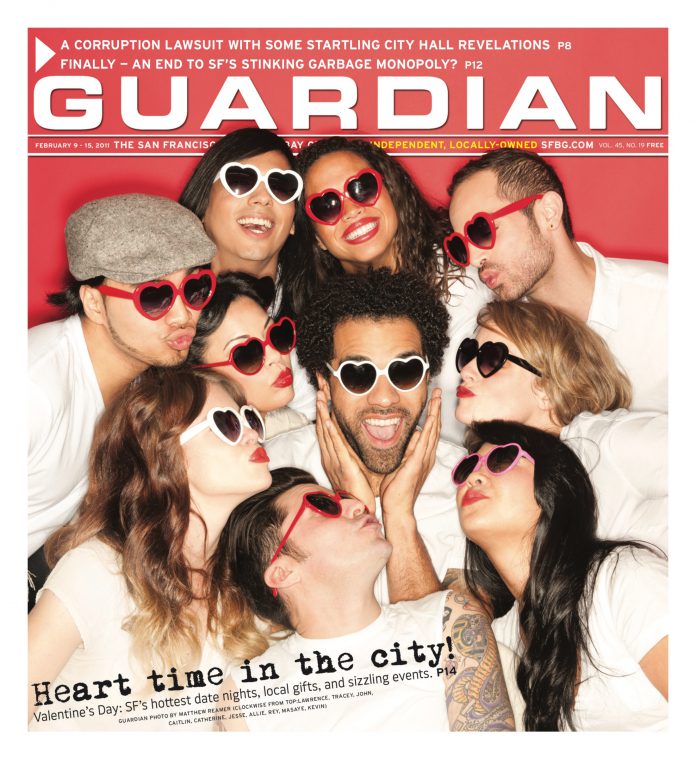arts@sfbg.com
MUSIC Because of the rusty pieces of corrugated sheet metal crudely affixed to its exterior, I almost mistake Tiny Telephone, a recording studio, for a very large, dilapidated storage unit. But on a brick-red door, alphabet letter magnets spell out “tiny,” and only bits of dried glue and fragments of “telephone” remain. This must be it.
Through the door, a two-wall art installation made of reclaimed redwood (by resident artist Claire Mack) in the lounge/kitchen area catches my eye. I’ve seen pictures of it on the studio’s website. This is it. It’s easy to imagine Death Cab For Cutie or San Francisco songstress Thao drinking beer, shooting the shit, and jamming in this room.
Once I plop down on the couch, pop-folk icon John Vanderslice, owner and manager of Tiny Telephone, pulls up a chair. Minna Choi, the artistic director of Magik*Magik Orchestra, the studio’s official house orchestra, takes a seat on a tan area rug.
“It’s probably like how everyone feels when you’re from San Francisco and you move to the East Coast and there are no good taquerias,” Vanderslice says, laughing, when I ask him about the history of Tiny Telephone. “I was in a small local band,” he elaborates. “We wanted to make a record. We toured every local studio. It was like there were only either rehearsal places with garbage on the floor, or posh, unaffordable, hardwood-floor, uptight-owner situations. There was nothing in the middle.”
In September 1997, Vanderslice opened Tiny Telephone to give independent musicians the opportunity to make affordable hi-fi recordings. Magik*Magik Orchestra entered the picture in 2008. “We wanted to simplify the process of incorporating classically-trained musicians into a nonclassical environment,” Choi says. “So I e-mailed [John].”
“It was like genius!” Vanderslice blurts out.
Adding the orchestra to Tiny Telephone is in tandem with Vanderslice’s evolution as an artist. On 2004’s Cellar Door (Barsuk), he strayed from electric guitar and used acoustic guitar and keyboards. “[Electric guitars] really take up a lot of territory,” he explains. “It’s a little bit like a cock-block. [Keyboards] can sit in one area, and then you can put something directly above them and below them in the frequency spectrum, so there’s plenty of room for, like, a French horn.” This year’s White Wilderness (Dead Oceans), finds Vanderslice’s tenor accompanied by acoustic guitar and a 19-piece ensemble gleaned from Magik*Magik Orchestra’s roughly 180-person membership.
“It’s great to go in a different direction,” Vanderslice says. “It’s great to move on.”
We all stand to start the tour. As I walk across the aqua blue floor, my hand grazes Fender amps that line the walkway to the main recording room. Inside, it’s dimly lit. When Vanderslice flips a switch, a white deer head becomes illuminated — like a statue of an idol — by Christmas lights strung on a pump organ. In one breath, he enumerates some of the equipment that is available: 14 guitar amps, a Hammond b3, a grand piano, keyboards, an EMT reverb plate. The lexicon of music recording equipment is dizzying. Vanderslice points to the walls: “These are all untreated cedar panels. This is cotton batting.” As we leave the room, he pauses to mention that the studio has been booked for more than 400 days in a row.
We climb a few rickety stairs to enter the control room, where we’re joined by Ian Pellicci, Tiny Telephone’s house engineer. With its UV meters, faders, and colored knobs, the room’s Neve console, built in 1976 for the BBC in London, looks like a prop taken from the bridge of the original Star Trek‘s Enterprise. This is the tape machine,” says Choi. “I’m proud to say that I was here when they put all of the light bulbs in, then all of a sudden it came alive like Wall-E.”
To encourage analog recording, Tiny Telephone provides free two-inch tape to clients. “Not that digital is terrible. But the technology has a ways to go,” Pellicci says. “There’s a greater dimension to the sound [of analog].”
Next we shuffle into the isolation room. “We’re basically in an anechoic isolation room where people can do vocals, drums — ” Vanderslice begins to explain. But with the room’s door open, I can hear the raucous sounds of construction taking place down the hallway.
Next door, what once was an auto shop is being converted into a separate studio, a “B Room” Opening in June, the B Room will be set up as an arts nonprofit modeled after The Bay Bridged and 826 Valencia. Unlike Tiny Telephone, which costs $350 per day plus engineers, the B Room will cost $200 daily. “We wanted to give bands a low-cost option to record on a tape machine, on a real console with microphones, in a space where they can make as much noise as they want,” says Vanderslice.
“With this other price point, [Vanderslice] is tapping into another group of bands and artists,” Choi adds. “There are probably so many diamonds in the rough — crazy talent waiting to be discovered.”
As the tour winds down, Vanderslice shares his vision of Tiny Telephone and the B Room: “We’re going to put a picnic table outside, a basketball hoop — we’re going to build community. And that’s what it’s all about.”

